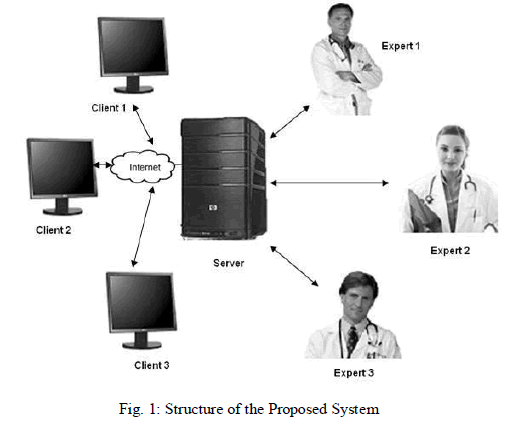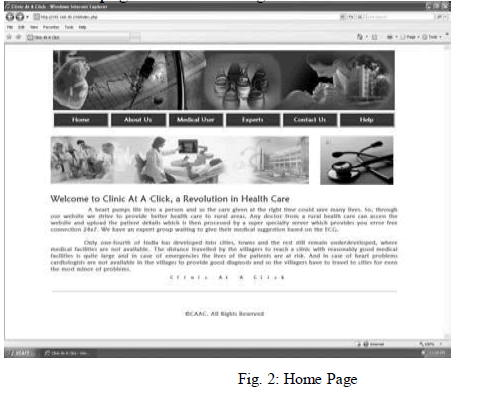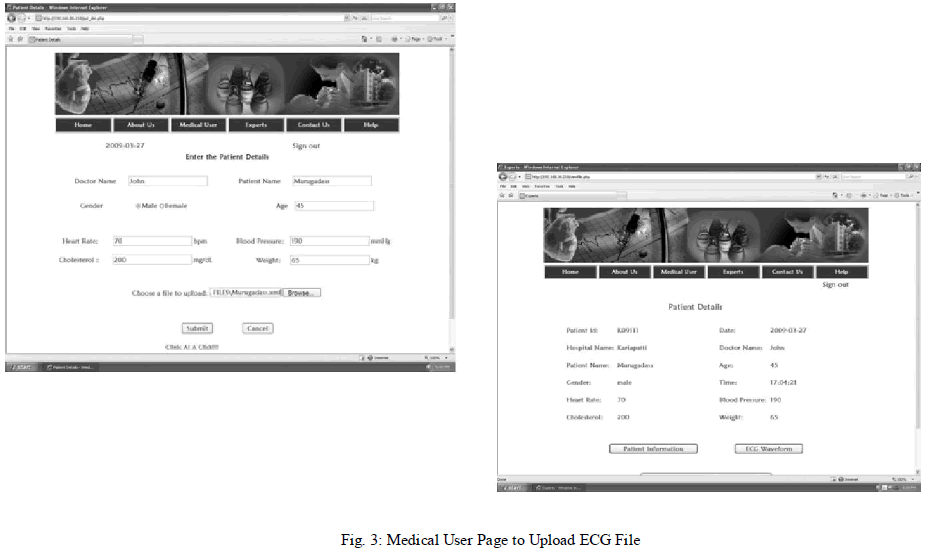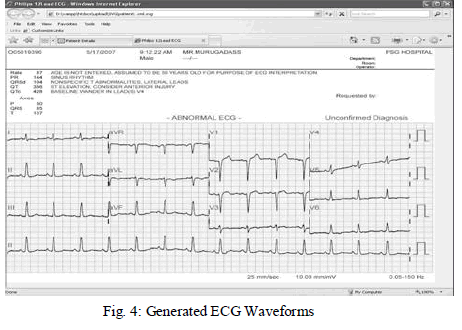ISSN ONLINE(2278-8875) PRINT (2320-3765)
ISSN ONLINE(2278-8875) PRINT (2320-3765)
| Dr.T.V.U.Kiran Kumar HOD, Dept Of ECE, Bharath University, Chennai-600073, India |
| Related article at Pubmed, Scholar Google |
Visit for more related articles at International Journal of Advanced Research in Electrical, Electronics and Instrumentation Engineering
This paper presents the development of a web based telecardiology framework for the diagnosis of cardiac patients in rural areas. Rural health centers, a centralized server and expert cardiologists constitute the framework. Personal details, clinical information and ECG acquired from a patient at the rural center are sent to a centralized server. The server processes the ECG file to extract the lead measurements and the waveform data. The expert views the patient’s clinical information, lead measurements and ECG waveforms and submits his diagnosis for treatment. The server stores the diagnosed results and forwards the same to the respective rural center. The physician at the rural center can view the diagnosed results and recommendations from the expert and effect treatment.This telecardiology framework aims to provide health care to cardiac patients located at a distance. Implementation of this framework can change the way health care is delivered in cardiology.
Keywords |
| Telecardiology, health care, ECG diagnosis, XML-ECG files |
INTRODUCTION |
| The rapid development of the Internet and telecommunication has paved the way for the emergence of new teleconsultation systems. The internet supports system-independent platforms, providing access to many different computer systems. The client machines need to have only a web enabled network connectivity. Telecardiology, a branch of telemedicine, benefits patients by enabling treatment from a distant place, either from home or from a rural medical center. It helps cardiologists across the world to get connected and give consultations. Both cardiac patients and healthcare professionals can benefit from telecardiology [1,2,3,4]. |
| In many of the underdeveloped countries, majority of the population live in rural areas, where healthcare facilities are inefficient and inadequate. For example in India, over 80% of the main healthcare centers are located in the cities that host only 30% of the population [5]. This scenario reflects that only 20% of its quality healthcare facilities cater to almost 70% of the population. Hence, the rural population in general is more vulnerable than its urban counterpart. Telecardiology can therefore contribute substantially in bridging the urban- rural divide with respect to healthcare access. This justifies the need for implementing telecardiology for rural health care. |
| ECG analysis is a primary constituent of telecardiology. Though several computer-based techniques for the analysis of the ECG have been developed in the past, the techniques developed recently have provided remarkable clinical results [6,7]. However, because of technical support and cost, their implementation remains a difficult task in small-sized rural hospitals. |
| The system proposed by Jose Garcia et al [1] implements a framework hosting a server which runs an application to provide the diagnosis. The software in the server diagnoses the patient’s ECG and sends the result back to the client. Mitra M et al [8] have proposed a system which uses a portable telecardiology kit at the patient site to transmit the patient’s ECG and other findings to a PC at the health center using electromagnetic waves with a cordless phone. The PC processes the information and sends a report to the kit at the patient’s site. Here, the distance is limited to10km. The existing systems have their merits and applications but, they lack the involvement of expert cardiologists in the diagnostic process. The proposed web based system addresses these issues in providing a cost effective scalable solution for bringing quality health care to the unreached rural sector. |
| The main objectives of the work presented in this paper are (i) to develop an interface which permits the client (medical user) to connect to a centralized server via the internet and send locally acquired ECG files and (ii) to receive diagnosed results from expert cardiologists connected to the server via the internet. A block diagram of the proposed system is presented in Fig. 1. |
| This paper is organized as follows: XML Based File Format is introduced in section II, SVG for ECG display is dealt in section III, methods for implementation are discussed in section IV and conclusions are presented in section V. |
 |
XML-BASED ECG FILE FORMAT |
| Until recently, the native format for ECG files produced by the major cardiograph manufacturers has been binary files with compressed and encoded waveform data. The compression and encoding schemes were not published and easy access to the ECG waveform data by researchers and clinicians was not possible [9]. |
| To promote the concept of open ECG format for ease of use by researches and support interoperability between devices, Philips introduced the XML ECG format in their electrocardiographs [9,10]. XML is “a W3C-endorsed standard for document markup. It is a non presentable, data representation language. It defines a generic syntax used to mark up data with simple, human-readable tags”. XML document files are essentially tree-like structures containing labeled or “tagged” elements. Both the tags and the data elements are strings of text. Hence, readily available text editors and web browsers can be used to view the data in XML documents. To parse data contained in XML documents, a variety of software libraries are available in C, C++, C#, Perl and Java programming languages. In this work, Java has been used for the extraction of data from the XML file. |
| In March 2003, Philips Medical Systems released the Pagewriter Touch cardiograph, which was the first cardiograph by a major manufacturer to use XML format for ECG storage and transmission [9]. |
SVG FOR ECG DISPLAY |
| To view ECG data in a graphical format, Scalable Vector Graphics (SVG), the XML-based graphics language, has been used. SVG, standardized by the W3C, is a powerful and flexible XML application language, ideally suited for display of two-dimensional graphics on a variety of display devices. Data in an XML document can be readily transformed into an SVG XML document. This document can be rendered onto a display by opening it with an SVG plug-in installed in the web browser [9]. Adobe’s SVG plug-in for Microsoft’s Internet Explorer is used in this work. |
METHODS |
A. Graphical User Interface |
| The GUI on the web page provides a user friendly access for the medical user (client) to upload and send the ECG file to the expert. |
| The interface is made simple for the user to navigate through the website. Various navigation tabs such as Medical User, Expert Cardiologist, Contact Us, |
| About Us and Help are provided in the home page as shown in Fig. 2. |
 |
B. User Authentication |
| To prevent unauthorized use, access to the system is restricted to authorized users (medical user and expert) who have a login and password defined in the server. All actions including login and log out are maintained in the database. The Message Digest (MD5) algorithm, intended for digital signature applications, is used to generate a digital signature. The passwords for medical user and expert are maintained in the database in the form of digital signatures. This algorithm takes a message of any arbitrary length as input and produces a 128-bit message digest of the input. MD5 algorithm is considered to be very safe since it is an irreversible algorithm. An MD5 hash is typically expressed as 32-digit hexadecimal number. MD5 is used in a wide variety of applications, and is also used to check the integrity of files [11]. Hence, this algorithm has been chosen. A second level of authentication has been provided through entry of the area code by the medical user. |
C. ECG File Transfer |
| After authentication, the user can upload the patient’s ECG file. A File browser dialog box is presented to the user to select a patient’s ECG file. A click on the submit button (shown in Fig. 3) transfers the file to the server. Here the store and forward type of ECG transmission is employed [12]. A confirmation message is displayed to inform the user that the file has been received in the server. |
| Philips software tool is used to convert XML ECGs into XML SVG files, which could then be used to view ECG waveforms on any PC with a SVG plug-in enabled web browser [9]. This SVG converter is placed in the server. The expert can view the patient’s ECG by just clicking the ECG waveform button on the patient details page as shown in Fig. 5. |
 |
D. Processing Techniques |
| The XML ECG file consists of two parts. The first part contains the patient’s personal details and numerical values of wave features of different leads, with tags providing the information to what each value denotes. The second part contains the compressed and encoded form of the ECG waveform that has to be used to display the ECG signal. A screenshot of the ECG waveform display is as shown in Fig. 4. |
 |
E. Expert Diagnosis |
| The expert logs in with username and password. A welcome page permits the expert to select a patient’s XML file and view the details of the patient. From the patient details page, Fig 5, the expert can view the numerical values of the ECG wave presented in the form of tables and also view the patient’s ECG waveforms. |
| The expert is also provided with a text area to enter his diagnosis and recommendations for treatment and submit the same by clicking the send report button, shown in Fig. 6. The submitted report is encrypted using the AES (Advance Encryption Standard) algorithm and transmitted. The report is then decoded at the client’s side and viewed by the medical user. |
 |
| The ECG XML file is processed in the server by software written in Java. The numerical values of the lead measurements in the ECG XML file are extracted in the server and displayed on the web browser for the expert to view. A Java applet is used for this purpose which can be embedded in the web browser. The applet displays the extracted details in the form of a table that is easily understood by the expert. When a Java enabled browser allows viewing the page containing an applet, the applet code is transferred to the system and executed by the browser’s Java Virtual Machine (JVM). |
CONCLUSION |
| A user-friendly web based telecardiology framework for the diagnosis of rural cardiac patients has been developed. The medical user (client) in the rural hospital needs to have only a PC with a web browser installed and a network connection. This framework facilitates patient diagnosis by an expert via the internet, in a centralized way, without the need to run programs on the local stations. |
| The proposed system has the following advantages: (i) ECG waveforms are displayed for easy diagnosis by expert cardiologists (ii) patients’post diagnostic information are stored in the server for future reference. |
| The system was configured both in the LAN and in the internet environments and found to work satisfactorily. Implementation of this framework by hospitals with rural centers can change the way health care is delivered in cardiology for rural patients. |
References |
|